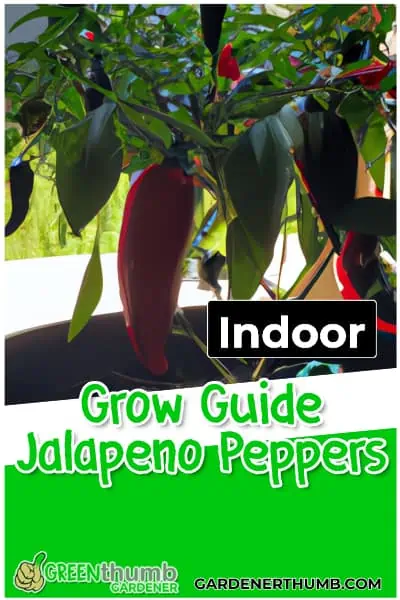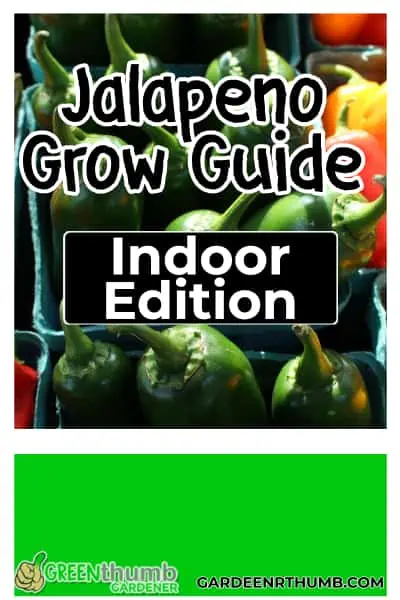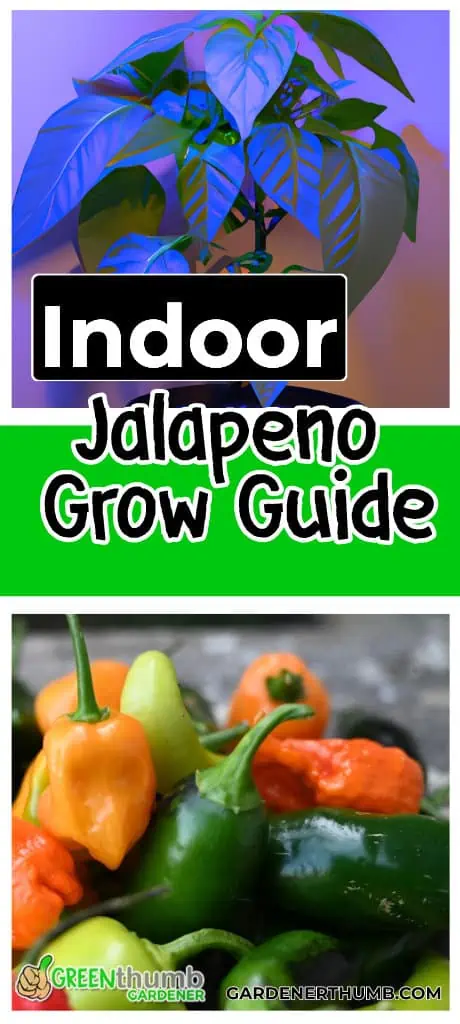Growing Jalapenos Indoors: A Step-by-Step Guide
Are you tired of bland meals and boring garden plants? Look no further than the trusty jalapeño pepper!
Not only do these little powerhouses pack a punch of flavor, but they also make for a beautiful addition to any garden.
These Capsicum annum plants and member of the nightshade family are easy to grow and maintain, bearing fruit for over five years.
Whether you’re whipping up some salsa, grilling for a BBQ, or just want to add a little heat to your sandwich, jalapeño peppers are the perfect choice. They always seem to find there way in my smoker with some cream cheese and bacon wrapped for some kick.
Don’t let their relatively low Scoville rating fool you – they may not be as scorching as the Carolina Reaper (with over two million), but they’re sure to bring some fire to your taste buds and your garden.
Like bell peppers, jalapenos are perennial plants that can keep growing and fruiting.
Are you ready to learn how to grow these jalapeño plants indoors?
Green thumb Gardener occasionally links to product and/or services offered by vendors to assist you with all your gardening needs. Some of these may be affiliate links, meaning we earn a small commission if items are purchased.
Want to Download a Garden Hack Guide for FREE

Enter your email below and we will send you a guide to help you SAVE money in your garden.
How to Grow Jalapenos Indoors
Growing jalapeno peppers indoors is a great way to enjoy fresh, flavorful, & hot pepper varieties year-round.
There are several ways to accomplish this, including starting seeds to transplant outdoors during the normal growing period, growing entirely indoors, and bringing peppers in to overwinter them.
1. Starting Seeds to Transplant Outdoors
A tried and true method for growing jalapenos indoors is by starting the seeds indoors and then transplanting the jalapeño plant outdoors during the normal growing period.
This is a great option if you want to give your plants a head start on the growing season.

I personally have had success with this method, by making sure to use a high-quality seed-starting mix and keeping the soil consistently moist but not waterlogged.
It’s crucial to wait until the seedlings have developed several true leaves before transplanting them into a sunny outdoor location.
Trust me, a little extra patience at this stage will pay off in the long run with a strong and healthy pepper plant.
2. Growing Entirely Indoors
If you don’t have access to an outdoor garden, or you simply prefer to keep your jalapenos indoors year-round, you can grow them entirely indoors.
Jalapenos prefer a warm, sunny location, so make sure to place your plants near a sunny window or under grow lights.
Keep the soil consistently moist, but not waterlogged, and fertilize every three weeks with a balanced fertilizer. During the winter, you need to make certain the area has some warmth near the roots of the plant and strong lighting.
3. Overwintering Peppers
Another option for growing jalapenos indoors is to bring peppers inside overwinter them. Jalapenos are perennials, which means that they can survive for several years, but in cold climates, they may not survive the winter.
To over-winter your peppers, bring them indoors before the first frost and place them in a sunny location or supplement them with indoor plant lighting. Make sure to provide them with enough light, keep the soil consistently moist, and fertilize every three weeks with a balanced fertilizer.
Once the threat of frost has passed, you can transplant your peppers back outside.
No matter which method you choose, growing jalapenos indoors is a great way to enjoy fresh peppers year-round.
With a little bit of care and attention, you can continue to harvest peppers throughout the winter and get a head start to next year if you transplant it back into the soil in early spring.
Step By Step Method To Start Jalapenos Indoors From Seeds
You can grow your own jalapenos from either seeds or seedlings. Growing habanero pepper seedlings is a simpler but more expensive method for some varieties.
On the other hand, growing jalapeno seeds may be slower but are more cost-effective in the long run for its sizes.
So, evaluate your options and go with the one that serves you best.
Growing jalapenos from seed require a temperature between 80 and 90 degrees Fahrenheit. So If you want to grow your jalapenos, you should plant the seeds indoors for about three months before the danger of frost has passed.
Growing jalapenos indoors requires the proper lighting and temperature conditions. You can use the following steps as a guide:
- If you want to cultivate your own jalapenos indoors, plant the seeds 1/4 inch deep in a pot or germination tray
- When planting seeds, it’s essential to keep the soil warm and moist. Make sure to add the appropriate amount of moisture to your seed-starting mixture and fill the tray inserts to about 3/4 capacity.
- You can speed up the sprouting process by placing your containers on a plant heat mat or the top of a refrigerator, both of which produce heat.
- During the germination period, expose the tray to grow lights for 16 hours
- Your Ideal soil should be moist but not drenched in water
- After the seedlings have germinated and produced two or three sets of leaves, they can be transplanted from your seedling trays into permanent larger containers
- To ensure there is enough room for the adult jalapeno plant, transplant the seedlings to a larger 2-gallon or 5-gallon pot
- To ensure optimal growth and nutrition for your plants, it is recommended to either apply a balanced fertilizer every three weeks or incorporate controlled-release fertilizer into the soil before transplanting new plants.
- If you want your peppers to continue blooming, pick them as soon as they’re ready.
Jalapeno Pepper Soil Requirements
Soil is home to various organisms that work together to improve soil conditions, recycle vital nutrients, and suppress pests, weeds, and diseases that could otherwise cause plant problems.
The perfect potting soil for cultivating jalapeno peppers is one that is loamy, abundant in nutrients, and efficiently drains excess water. Healthy soil is essential for sustainable agriculture.
To germinate, jalapenos need a soil temperature of at least 70 degrees Fahrenheit.
Soil helps plants grow and flourish by supplying them with water, nutrients, oxygen, and root support, increasing agricultural yields.
Avoid keeping the soil too wet and heavy in between watering when growing jalapenos.
They thrive in moist soil with a neutral pH but can even make do in slightly acidic or alkaline conditions. A pH test kit can be used to determine the normal pH level of your soil.

Jalapenos don’t have particular soil preferences, but they benefit from a well-balanced potting mix that includes organic matter and a touch of slow-release fertilizer. To control soil moisture effectively, you can add a potting mix consisting of peat moss, organic matter, and other ingredients.
While jalapeno pepper plants are rarely affected by pests or insect, they can get leaf diseases.
Make sure there is enough space between each pepper plant to allow air circulation and reduce the likelihood of infections. Jalapenos can grow from 2 to 3 feet tall, so that they will need at least a foot spacing in between.
Jalapeno Pepper Indoor Lighting Requirements
Light is an essential ingredient in growing jalapeños indoors. Light is necessary for photosynthesis, the process through which a plant turns light, oxygen, and water into carbohydrates.
Plants use this energy to grow, blossom, and reproduce. After reaching full maturity, your plant should receive 16 hours of sunlight per day.
Jalapeno will survive in partial shade if necessary but thrive in a sunny spot.
However, they may suffer from a lack of sunlight if you keep them indoors. Artificial lights, such as grow lights, are recommended in conjunction with natural light to address this problem.
A sunny window will not provide enough light to grow your plans. They need 12-16 hours of light per day to grow properly. Compact fluorescent lamps (CFLs) and other fluorescent bulbs are ideal for germinating pepper seeds.
Peppers need light to survive and produce fruits throughout the growing season.
Jalapeno Pepper Water Requirements
Morning is the ideal time to water your pepper plants. This allows the soil to dry out and prevents it from getting soggy during the day.
The lack of rain or other natural precipitation means that an indoor jalapeno plant must be given a steady supply of water. The roots cannot spread outward or downward as they would in a natural environment in search of water because the container confines them.
The benefits of giving your potted jalapeno plants water are numerous. Jalapenos in pots will have robust plant growth and pepper yield if done properly.
Watering jalapeno plants in pots allows the water to penetrate down to the roots, which aids in absorbing nutrients.
Growing jalapeno peppers need a lot of water.
To ensure healthy plant growth, the soil should be kept consistently moist. It’s also important to remember that smaller containers require more frequent watering.
However, you don’t need to water your jalapenos every day. Every week, they need about 2.5 to 5.0 centimeters (1 to 2 inches) of water. To prevent overwatering your plants, you should always wait until the soil has begun to dry out before watering.
Keep the soil moist but not waterlogged or flooded.
To keep the soil moist for as long as possible, spread a thick layer of mulch over it. In addition, a layer of mulch will help prevent roots from freezing during colder months.
In addition, mulch will help retain heat and keep the soil warm during cold nights. Hot peppers thrive in temperatures between 18 and 26 degrees Celsius during the day and night temperatures over 13 degrees Celsius.
Jalapeno Pepper Fertilizing & Feeding Requirements
Pepper plants require a lot of nutrients and water from the soil. In addition, they require ideal conditions and continuous energy to grow robust roots and strong foliage.
They’ll need considerably more nutrients once they begin bearing fruit and blossoms. So before planting, make sure to Apply an all-purpose 5-10-10 vegetable garden fertilizer.
Be sure to provide your newly planted seeds with a healthy dose of nitrogen. Using a slow-release fertilizer worked into the soil before sowing seeds is recommended.
A second, smaller dose of a well-balanced fertilizer should be applied two to three weeks following germination.
Change to a 5-10-10 or a 3-5-5 fertilizer when you observe flower buds opening, as this signals the plant’s transition toward flowering and fruiting.
A quick online search will reveal hundreds of different fertilizer manufacturers. Every gardener has a go-to method that yields the best results, so it’s essential to try out several mixtures and brands to see what works for you and your plants.
Final Thoughts
Peppers are a delicious addition to various recipes and dishes. Whether you grow them indoors or outdoors will rely primarily on your personal preference and available space.
You can cultivate chili peppers like Jalapenos indoors under lights regardless of whether you are in an apartment or have limited space.
The benefit of growing your jalapeno peppers indoors is that you can enjoy a steady supply of freshly picked peppers all year round. Don’t forget to also save your jalapeno pepper seeds from your best plants to have them grow even better the next year.








